Implementation of Food Retail Functions in Poland in the SARS-CoV-2 Pandemic
Abstract
1. Introduction
2. Materials and Methods
2.1. Research Problem, Objectives, and Hypotheses
2.2. Scope of Work and Phases of Its Execution
- Very favorable geopolitical location from the point of view of trade. It borders with Germany, which provides access to an attractive market for food products and supply imports in Western European countries;
- Membership of the Pro Europa Viadrina Euroregion and the Spree-Nysa-Bobr Euroregion, which provides good conditions for interregional trade cooperation;
- Developed regional communication network, road and railroad, as well as water transport (14 border crossings), which reduces the logistics and distribution risk of food products;
- The high share of the voivodeship’s agriculture in the creation of a GDP of 3.5% in 2019, (with the national average of 2.1%) provides raw materials for processing and finished products for the food market;
- Natural conditions (nonindustrialized area) create opportunities for the development of the regional organic food market and Lubuskie’s 8th place in the country in 2020 in terms of the number of organic producers [45] (p. 23).
2.3. Interpretation of the Basic Economic Categories Used in This Paper
- F1—Food security, which is realized by securing the constant access of consumers in place and time to the quantity and value of food products (social function);
- F2—To satisfy the preferences of buyers by adjusting the structure of the food offered (social function);
- F3—Disciplining the increase of the selling prices of goods due to the prevention of the decrease in purchasing power of the population (social function);
- F4—Ensuring the supply of food products to consumers (logistic, distribution, and control function);
- F5—The development of its own production potential, its modernization, and restructuring for a competitive increase of the company’s value and its position in the market (economic and development function);
- F6—Securing jobs for employees, through various flexible working time solutions, in the field of selling food to consumers (social function);
- F7—Using promotion for cognitive purposes and building a new consumer culture (information and education function).
2.4. Research Methods Used
- On the turnover of the stores under study (Variables 1–11);
- On the performance of economic functions (Variables 12–28);
- On the performance of supply and procurement chains (Variables 29–35c).
3. Results and Discussion
3.1. Literature Review
3.2. Empirical Results
3.2.1. Social Function Realization
3.2.2. Performance of Economic Functions
3.2.3. Implementation of Logistics and Control Functions
3.2.4. Degree of Performance of Food Retailing Functions as Assessed by Respondents (Likert Scale)
4. Conclusions
- Negative phenomena due to the 2020–2021 pandemic, which occurred in Poland, did not have a reductive effect on the performance of its socioeconomic functions in food retailing;
- The main barriers to the performance of the functions by food retailing were mainly external factors;
- The fulfillment of the logistic function by food retailing depended mainly on the internal factors of individuals, conditioning the efficiency of supply chains.
Author Contributions
Funding
Institutional Review Board Statement
Informed Consent Statement
Data Availability Statement
Acknowledgments
Conflicts of Interest
References
- Meadows, D.H.; Meadows, D.L.; Randers, J.; Behrans, W.W., III. The Limits to Growth. A Report for the Club of Rome’s Project on the Predicament of Mankind; Universe Books: New York, NY, USA, 1972; Available online: http://www.donellameadows.org/wp-content/userfiles/Limits-to-Growth-digital-scan-version.pdf (accessed on 15 July 2021).
- Mesarovic, M.; Pestel, E.; Karunaratne, N.D. Mankind at the Turning Point—The Second Report of the Club of Rome. Econ. Anal. Policy 1976, 6, 69–73. [Google Scholar] [CrossRef]
- Brunland, G.H. Report of the World Commission on Environment and Development. Our Common Future; United Nations World Commission on Environment and Development: Oslo, Norway, 1987; Available online: https://www.are.admin.ch/are/en/home/media/publications/sustainable-development/brundtland-report.html (accessed on 15 June 2021).
- Nordhaus, W.D. Reflections on the Economics of Climate Change. J. Econ. Perspect. 1993, 7, 11–25. [Google Scholar] [CrossRef]
- Hardin, G. The Tragedy of the Unmanaged Commons. Trends Ecol. Evol. 1994, 9, 199. [Google Scholar] [CrossRef]
- Williamson, O.E. Organizational Forms and Internal Efficiency. Markets and Hierarchies: Some Elementary Considerations. Am. Econ. Rev. 1973, 63, 316–325. [Google Scholar]
- Coase, R. The New Institutional Economics. Am. Econ. Rev. 1998, 88, 72–74. [Google Scholar]
- Common, M.; Stagl, S. Ecological Economics: An Introduction; Cambridge University Press: Cambridge, UK, 2012. [Google Scholar] [CrossRef]
- UNDP. 2019. Available online: http://hdr.undp.org/sites/default/files/hdr2019.pdf (accessed on 25 June 2021).
- Eurostat. 2020. Available online: https://ec.europa.eu/eurostat/databrowser/view/tessi190/default/table?lang=en (accessed on 25 June 2021).
- Flores, L.; Shields, L. I Can Hardly Sustain My Family. Understanding the Human Cost of the COVID-19 Pandemic for Workers in the Supply Chain. 2020. Available online: https://www.bsr.org/reports/BSR-HERproject-Human-Cost-Pandemic-Report.pdf (accessed on 28 June 2021).
- Siche, R. What is the impact of COVID-19 disease on agriculture? Sci. Agropecu. 2020, 11, 3–6. [Google Scholar] [CrossRef]
- Swinnen, J.; McDermott, J. (Eds.) COVID-19 and Global Food Security; International Food Policy Research Institute: Washington, DC, USA, 2020; Available online: https://www.ifpri.org/publication/covid-19-and-global-food-security (accessed on 15 June 2021). [CrossRef]
- Swinnen, J.; McDermott, J. Covid-19 and Global Food Security. EuroChoices. Spec. Issue COVID-19 Pandemic Impacts Agri-Food Syst. 2020, 19, 26–33. [Google Scholar] [CrossRef]
- FAO. 2020. Available online: http://www.fao.org/state-of-food-security-nutrition/en/ (accessed on 25 June 2021).
- State of Food Security and Nutrition in the World—Report. 2021. Available online: https://docs.wfp.org/api/documents/WFP-0000130141/download/?_ga=2.178006368.474335531.1628174697-307477829.1628174697&_gac=1.124970488.1628174707.CjwKCAjwmK6IBhBqEiwAocMc8loAYWieQsmDHGOKSKYNepoJh6lzlUhecl01nTX77H-WaD5Zop3EgRoCgtQQAvD_BwE (accessed on 25 June 2021).
- Pujawan, I.N.; Bah, A.U. Supply chains under COVID-19 disruptions: Literature review and research agenda. Supply Chain. Forum Int. J. 2021. [Google Scholar] [CrossRef]
- Gruszczynski, L. The COVID-19 Pandemic and International Trade: Temporary Turbulence or Paradigm Shift? Eur. J. Risk Regul. 2020, 11, 337–342. [Google Scholar] [CrossRef]
- Rejeb, A.; Rejeb, K.; Keogh, J.G. Covid-19 and the food chain? Impacts and future research trends. LogForum 2020, 16, 475–485. [Google Scholar]
- Darvas, Z. The Unequal Inequality Impact of the Covid-19 Pandemic. Working Paper, Brugel, Brussels, 2021, 06. Available online: https://www.bruegel.org/wp-content/uploads/2021/03/WP-2021-06_30032021.pdf (accessed on 25 June 2021).
- World Bank. Available online: www.worldbank.org/en/topic/agriculture/brief/food-security-and-covid-19 (accessed on 25 June 2021).
- Jędrzejczyk, I. Ekspozycja na ryzyko sytuacji pandemicznej COVID-19 i wrażliwość społeczno-ekonomiczna obszarów wiejskich i agrobiznesu. Ubezpieczenia Rolnictwie. Mater. Studia 2020, 1, 7–71. [Google Scholar] [CrossRef]
- FAO. 2018. Available online: http://www.fao.org/faostat/en/#data/FSB (accessed on 25 June 2021).
- Kafkadesk. Poland Ranks First in Food security Index in Central and Eastern Europe. 2020. Available online: https://kafkadesk.org/2020/01/18/poland-ranks-first-in-food-security-index-in-central-and-eastern-europe/ (accessed on 6 September 2021).
- Global Food Security Index. 2020. Available online: https://foodsecurityindex.eiu.com/Index (accessed on 1 September 2021).
- FAO. 2020. Available online: http://www.fao.org/fao-who-codexalimentarius/news-and-events/news-details/en/c/1274005/ (accessed on 25 June 2021).
- Grzeszak, J.; Leśniewicz, F.; Śliwowski, P.; Święcicki, I. Pandenomics. Zestaw Narzędzi Fiskalnych i Monetarnych w Dobie Kryzysów; Polski Instytut Ekonomiczny: Warszawa, Poland, 2020; Available online: https://pie.net.pl/wp-content/uploads/2020/04/PIE-Pandenomics.pdf (accessed on 30 June 2021).
- Kowalczyk, S. Sektor żywnościowy w czasach pandemii [Food Sector in Times of Pandemic]. Kwart. Nauk. Przedsiębiorstwie 2020, 56, 43–53. [Google Scholar] [CrossRef]
- Bontempi, E.; Coccia, M. International trade as critical parameter of COVID-19 spread that outclasses demographic, economic, environmental, and pollution factors. Environ. Res. 2021, 201, 111514. [Google Scholar] [CrossRef] [PubMed]
- Curran, L.; Eckhardt, J.; Lee, J. The trade policy response to COVID-19 and its implications for international business. Crit. Perspect. Int. Bus. 2021, 17, 252–320. [Google Scholar] [CrossRef]
- Hayakawa, K.; Mukunoki, H. The impact of COVID-19 on international trade: Evidence from the first shock. J. Jpn. Int. Econ. 2021, 60, 101135. [Google Scholar] [CrossRef]
- Carreño, I.; Dolle, T.; Medina, L.; Brandenburger, M. The Implications of the COVID-19 Pandemic on Trade. Eur. J. Risk Regul. 2020, 11, 402–410. [Google Scholar] [CrossRef]
- Milea, C. Consequences of COVID-19 on the international trade in goods and services: Forecasts, developments, restrictions. National Institute of Economic Research (INCE), “Victor Slăvescu” Centre for Financial and Monetary Research, Bucharest. Financ. Stud. Rom. Acad. 2020, 24, 29–40. [Google Scholar]
- Skawińska, E.; Zalewski, R.I. The Role of International Organizations in International Economic Relations in the Context of Sustainable Development. Acta Sci. Polonorum. Oeconomia 2017, 16, 141–149. [Google Scholar] [CrossRef]
- Barska, A.; Jędrzejczak-Gas, J.; Wyrwa, J.; Kononowicz, K. Multidimensional Assessment of the Social Development of EU Countries in the Context of Implementing the Concept of Sustainable Development. Sustainability 2020, 12, 7821. [Google Scholar] [CrossRef]
- Skawińska, E.; Zalewski, R.I. Impact of Coronavirus Covid-19 on the Food System. Acta Sci. Polonorum. Oeconomia 2020, 19, 121–129. [Google Scholar] [CrossRef]
- Ambroziak, Ł. Wpływ pandemii COVID-19 na handel rolno-spożywczy Polski: Pierwsze doświadczenia [The Impact of the Pandemic COVID-19 on Agri-Food Trade of Poland: First Experiences]. Zeszyty Naukowe SGGW w Warszawie. Probl. Rol. Swiat. 2020, 20, 5–17. [Google Scholar]
- Ambroziak, Ł.; Chojna, J.; Gniadek, J.; Krawczyk, A.; Marczewski, K.; Sawulski, J. Transformacja Polskiego Eksportu—30 Lat Wzrostu i co Dalej? Polski Instytut Ekonomiczny: Warszawa, Poland, 2020; Available online: https://pie.net.pl/wp-content/uploads/2021/02/PIE-Transformacja-eksportu.pdf (accessed on 15 August 2021).
- Strange, R. The 2020 Covid-19 pandemic and global value chains. J. Ind. Bus. Econ. 2020, 47, 455–465. [Google Scholar] [CrossRef]
- Baldwin, R.E.; Tomiura, E. Thinking ahead about the trade impact of COVID-19. In Economics in the Time of COVID-19; Baldwin, R., Weder di Mauro, B., Eds.; Centre for Economic Policy Research: London, Great Britain, 2020; pp. 59–71. Available online: https://cepr.org/sites/default/files/news/COVID-19.pdf (accessed on 10 August 2021).
- Szczepaniak, I.; Ambroziak, Ł.; Drożdż, J. Wpływ pandemii COVID-19 na przetwórstwo spożywcze i eksport rolno-spożywczy Polski [Impact of the COVID-19 pandemic on food processing and Polish agri-food exports]. Ubezpieczenia Rolnictwie. Mater. Studia 2020, 1, 117–163. [Google Scholar] [CrossRef]
- Statistical Office in Zielona Góra. Available online: https://zielonagora.stat.gov.pl/en/ (accessed on 30 June 2021).
- Strategia Rozwoju Województwa Lubuskiego 2030 przyjęta przez Sejmik Województwa Lubuskiego w Dniu 15 Lutego 2021 roku, Załącznik nr 1 do Uchwały Nr XXVIII/397/21 Sejmiku Województwa Lubuskiego z Dnia 15 Lutego 2021 r.; Zielona Góra, Poland. 2021. Available online: https://bip.lubuskie.pl/system/obj/51530_SRWL_2030__czysty_OST_19.02.2021.pdf (accessed on 30 June 2021).
- Raport o Stanie Województwa za rok 2020; Zielona Góra, Poland. 2021. Available online: https://bip.lubuskie.pl/system/obj/51025_Raport_o_stanie_wojewodztwa_2020_19_05.pdf (accessed on 30 June 2021).
- Raport o Stanie Rolnictwa Ekologicznego w Polsce w Latach 2017–2018 [The Report on Organic Farming in Poland in 2017–2018]. Inspekcja Jakości Handlowej Artykułów Rolno-Spożywczych: Warszawa, Poland, 2019. Available online: https://www.gov.pl/web/ijhars/raport-o-stanie-rolnictwa-ekologicznego-w-polsce (accessed on 30 June 2021).
- Powęska, H. Functions of Retail Trade in the Borderlands of Poland: A Theoretical Perspective. Acta Sci. Polonorum. Oeconomia 2011, 10, 65–74. [Google Scholar]
- Kucharska, B.; Kucia, M.; Maciejewski, G.; Malinowska, M.; Stolecka-Makowska, A. The Retail Trade in Europe-Diagnosis and Future Perspectives; Publishing House of the University of Economics in Katowice: Katowice, Poland, 2015; pp. 10–11. Available online: https://www.researchgate.net/publication/327860965_The_retail_trade_in_Europe-diagnosis_and_future_perspectives_Barbara_KUCHARSKA_Michal_KUCIA_Grzegorz_MACIEJEWSKI_Miroslawa_MALINOWSKA_Agata_STOLECKA-MAKOWSKA (accessed on 10 September 2021).
- Macfadyen, S.; Tylianakis, J.M.; Letourneau, D.K.; Benton, T.G.; Tittonell, P.; Perring, M.; Gómez-Creutzberg, C.; Báldi, A.; Holland, J.M.; Broadhurst, L.; et al. The role of food retailers in improving resilience in global food supply. Glob. Food Secur. 2015, 7, 1–8. [Google Scholar] [CrossRef]
- HDE (Handelsverband Deutschland). Handelsreport Lebensmittel. Fakten zum Lebensmitteleinzelhandel; FMCG-Brancheninformationssystem des HDE und IFH für den Einzelhande. 2018. Available online: https://einzelhandel.de/images/HDE-Publikationen/HDE_IFH_Handelsreport_Lebensmittel_2018.pdf (accessed on 9 September 2021).
- Cadilhon, J.J.; Fearne, A.P.; Hughe, D.R.; Moustier, P. Wholesale Markets and Food Distribution in Europe: New Strategies for Old Functions; Discussion Paper; Centre for Food Chain Research, Imperial College: London, UK, 2003; Available online: https://citeseerx.ist.psu.edu/viewdoc/download?doi=10.1.1.587.4053&rep=rep1&type=pdf (accessed on 9 September 2021).
- Raoult-Wack, A.-L.; Bricas, N. Food Sector Development: Multifunctionality and Ethics. E J. CIGR (Comm. Int. du Genie Rural.) 2001, 3. Available online: https://ecommons.cornell.edu/bitstream/handle/1813/10253/CIGR%20invited%20paper-Food%20Sector%20Develpment.pdf?sequence=1&isAllowed=y (accessed on 9 September 2021).
- Skripnuk, D.F.; Davydenko, V.A.; Romashkina, G.F.; Khuziakhmetov, R.R. Consumer Trust in Quality and Safety of Food Products in Western Siberia. Agronomy 2021, 11, 257. [Google Scholar] [CrossRef]
- FAO. Implications of Economic Policy for Food Security: A Training Manual. 1999. Available online: http://www.fao.org/3/x3936e/x3936e03.htm (accessed on 7 July 2021).
- FAO. Food Self-Sufficiency and International Trade: A False Dichotomy? 2015–2016. Available online: http://www.fao.org/3/i5222e/i5222e.pdf (accessed on 6 September 2021).
- Clapp, J. Food self-sufficiency: Making sense of it, and when it makes sense. Food Policy 2017, 66, 88–96. [Google Scholar] [CrossRef]
- Szczepaniak, I. Ocena bezpieczeństwa żywnościowego i samowystarczalności żywnościowej Polski na tle państw Unii Europejskiej [Assessment of Food Security and Food Self-sufficiency of Poland as Compared to Other European Union Countries]. Int. Bus. Glob. Econ. 2018, 37, 168–182. [Google Scholar] [CrossRef]
- Beltran-Peña, A.; Rosa LD’Odorico, P. Global food self-sufficiency in the 21st century under sustainable intensification of agriculture. Environ. Res. Lett. 2020, 15, 095004. [Google Scholar] [CrossRef]
- Sadowski, A.; Baer-Nawrocka, A. Food Self-Sufficiency of the European Union Countries—Energetic Approach. J. Agribus. Rural. Dev. 2016, 40, 407–414. [Google Scholar] [CrossRef]
- Aday, S.; Aday, M.S. Impact of COVID-19 on the food supply chain. Food Qual. Saf. 2020, 4, 167–180. [Google Scholar] [CrossRef]
- Gołębiewski, J. Systemy Żywnościowe w Warunkach Gospodarki Cyrkularnej. Studium Porównawcze Krajów Unii Europejskiej; Wydawnictwo SGGW: Warszawa, Poland, 2019. [Google Scholar]
- Segetlija, Z.; Franjković, J. Retail Formats in Regional Supply Chains. Josip Juraj Strossmayer University of Osijek, Faculty of Economics, Croatia. Bus. Logist. Mod. Manag. 2018, 18, 285–298. [Google Scholar]
- Kapusta, F. Bezpieczeństwo żywnościowe Polski i jej mieszkańców w okresie przedakcesyjnym i po akcesji do Unii Europejskiej [Food Security of Poland and its Inhabitants During the Pre-Accession and After Accession Period to the European Union]. Ekon. XXI Wieku 2016, 4, 68–86. [Google Scholar] [CrossRef][Green Version]
- FAO. Sustainable Food Value Chains Knowledge Platform. 2021. Available online: http://www.fao.org/sustainable-food-value-chains/what-is-it/en/ (accessed on 25 June 2021).
- Krzanowski, W.J. Principles of Multivariate Analysis. A User’s Perspective; Oxford University Press: Oxford, UK, 2000. [Google Scholar]
- Zalewski, R.I. Principal Component Analysis as a tool in organic and food chemistry. In Similarity Models in Organic Chemistry, Biochemistry and Related Fields; Zalewski, R.I., Krygowski, T.M., Shorter, J., Eds.; Elsevier Science Publishers: Amsterdam, The Netherlands, 1991; pp. 455–556. [Google Scholar]
- Wachowiak, P. Wrażliwość społeczna przedsiębiorstwa jako istotna cecha współczesnego przedsiębiorstwa. In Przyszłość Zarządzania: Wyzwania w dobie Postglobalizacji [The Future of Management: Challenges in the Era of Post-Globalization]; Bojar, E., Ed.; Towarzystwo Naukowe Organizacji i Kierownictwa ”Dom Organizatora”: Lublin, Poland, 2020. [Google Scholar]
- Bacior, M. Kreowanie Wartości Firmy Jako cel Zarządzania Współczesnym Przedsiębiorstwem; Wydawnictwo CeDeWu: Warszawa, Poland, 2015. [Google Scholar]
- The EU’s 2021–2027 Long-Term Budget & NextGenerationEU; Publications Office of the European Union: Luxembourg, 2021; Available online: https://op.europa.eu/en/publication-detail/-/publication/d3e77637-a963-11eb-9585-01aa75ed71a1/language-pl (accessed on 7 September 2021).
- European Commission. Joint Communication to the European Parliament, the Council, the European Economic and Social Committee and the Committee of the Regions. Communication on the Global EU response to COVID-19; Brussels. 2020. Available online: https://op.europa.eu/en/publication-detail/-/publication/459ed2d1-7981-11ea-b75f-01aa75ed71a1/language-en (accessed on 10 July 2021).
- Skawińska, E.; Zalewski, R.I. Activities of Food Retail Companies in Poland during the COVID-19 Pandemic in the Context of Food Security. Sustainability 2021, 13, 7323. [Google Scholar] [CrossRef]
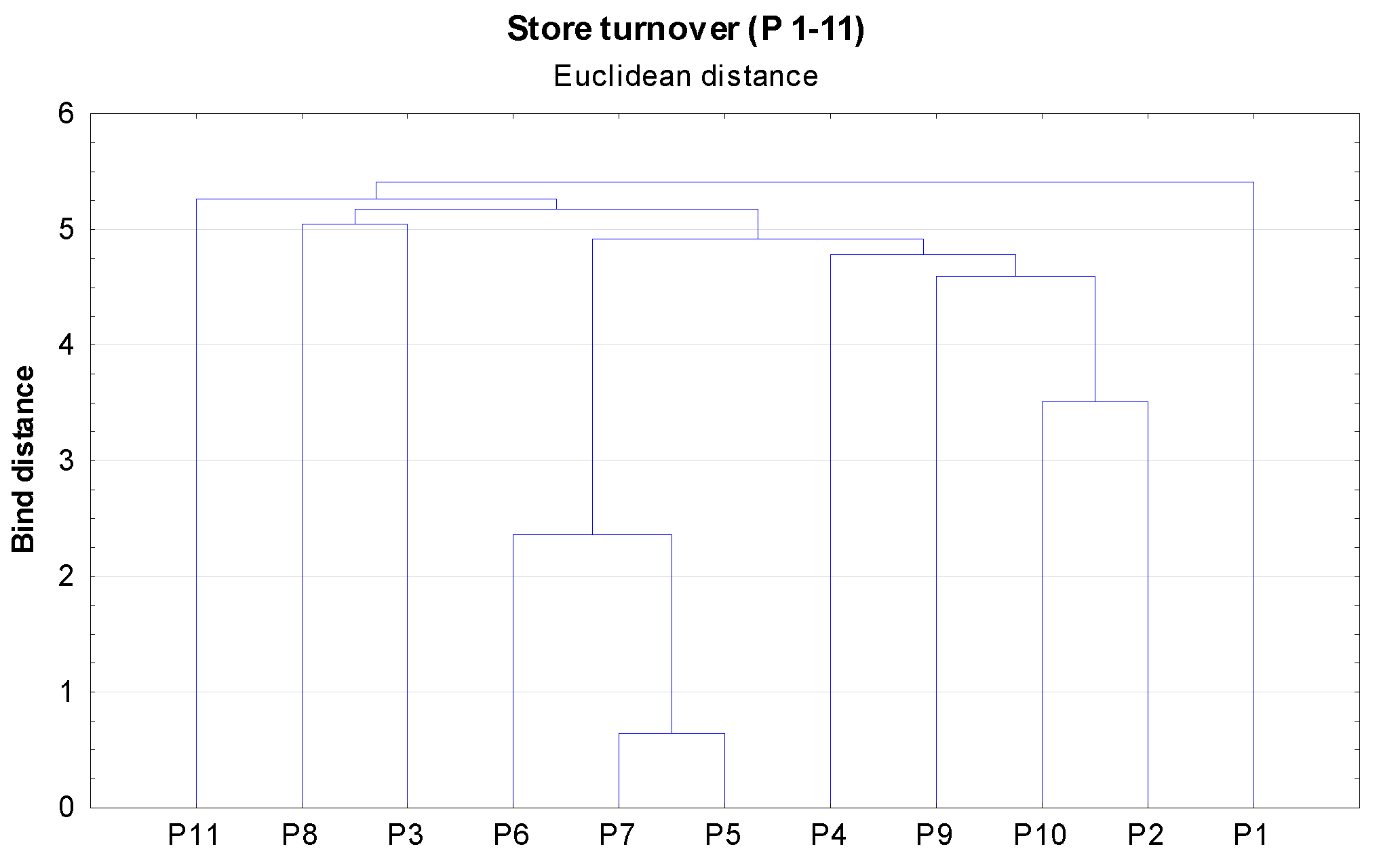
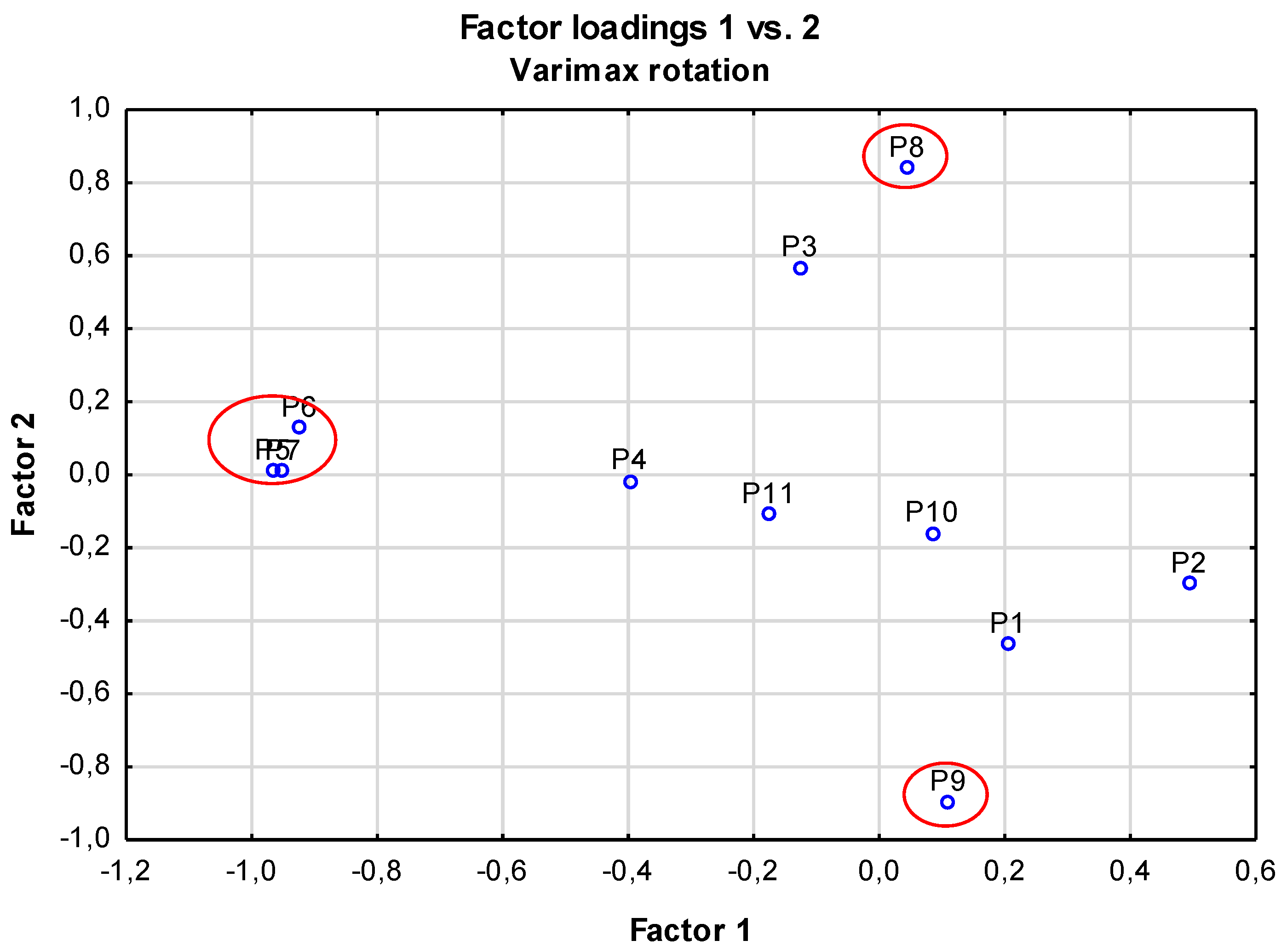
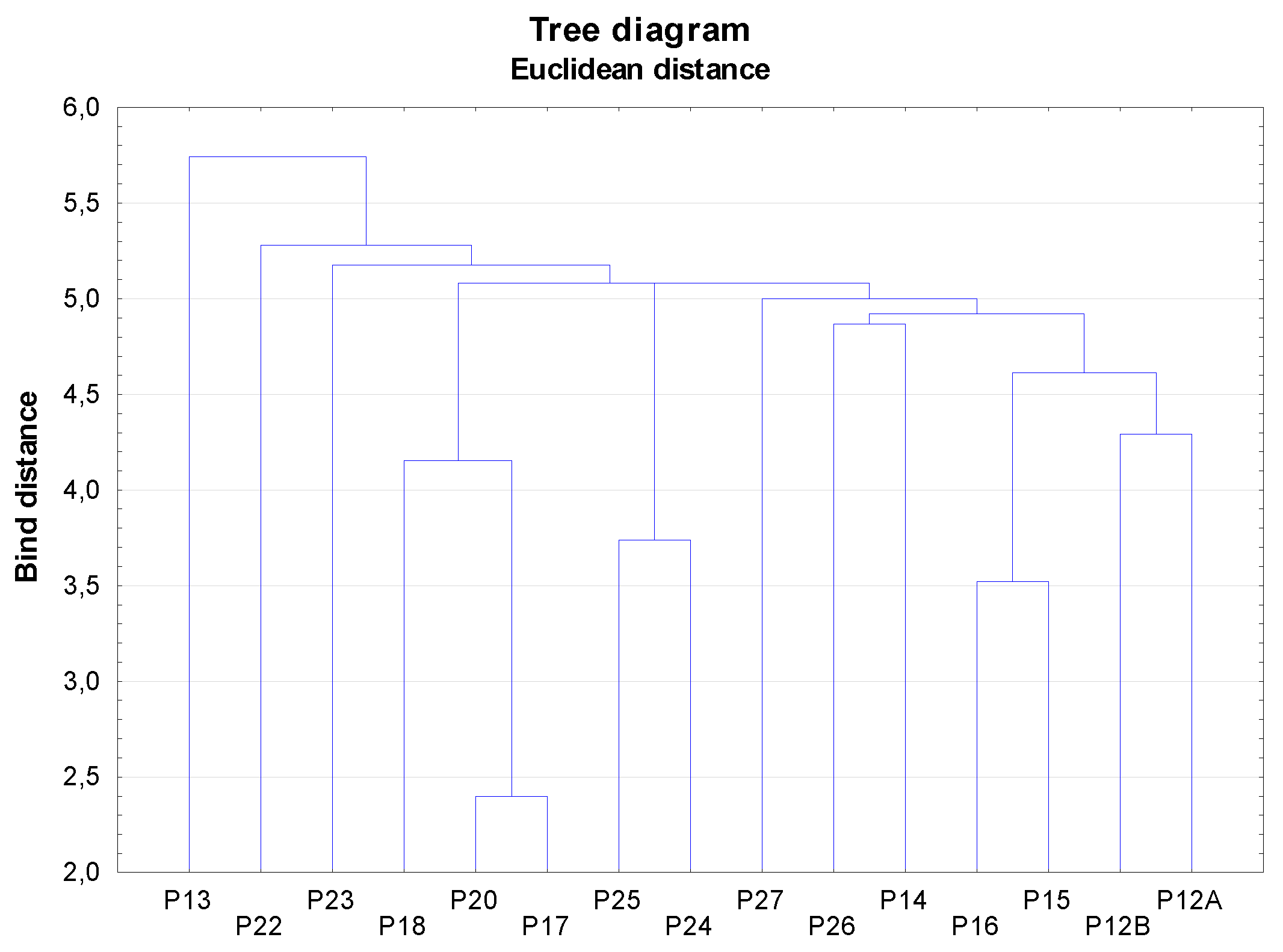

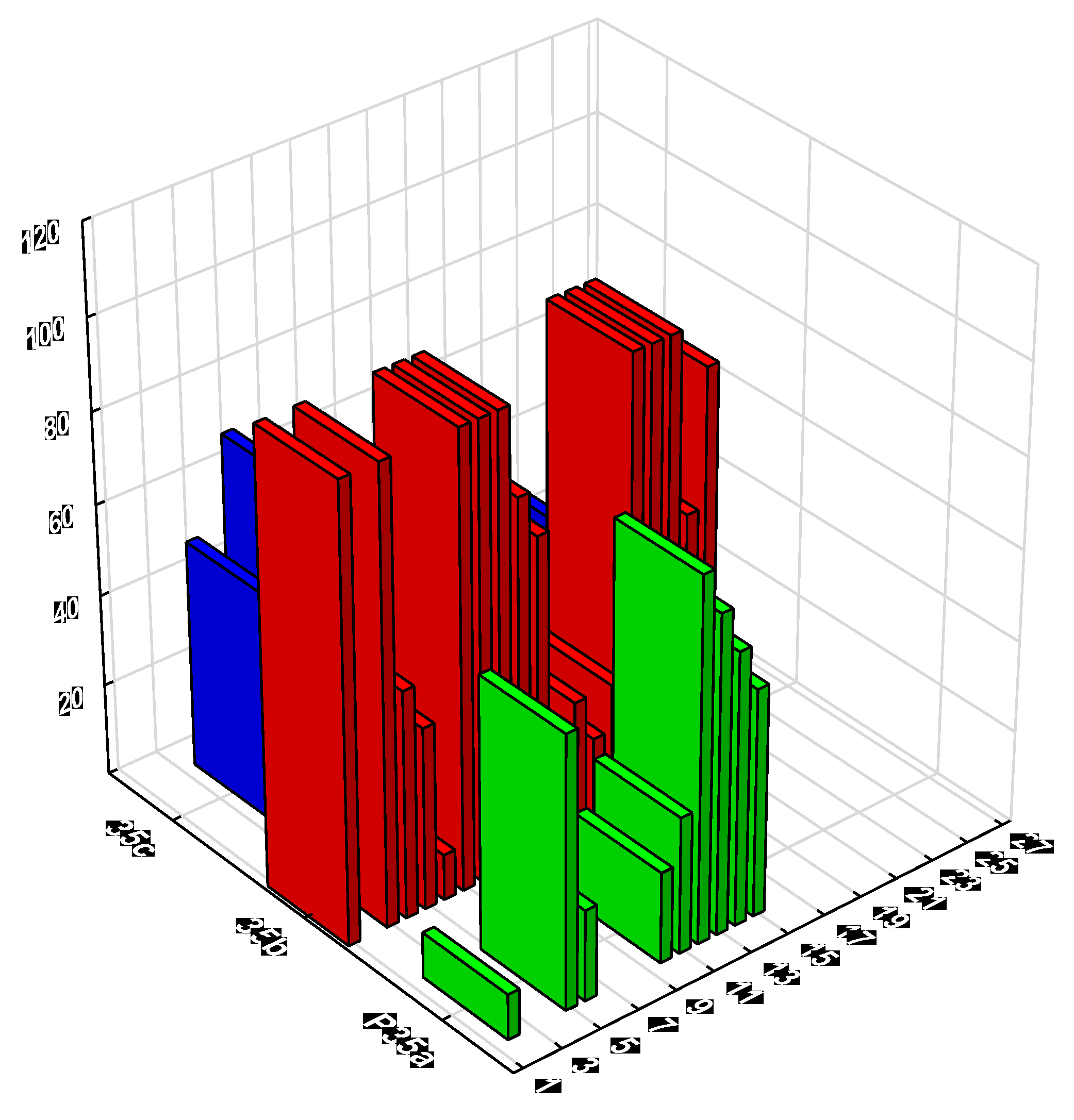
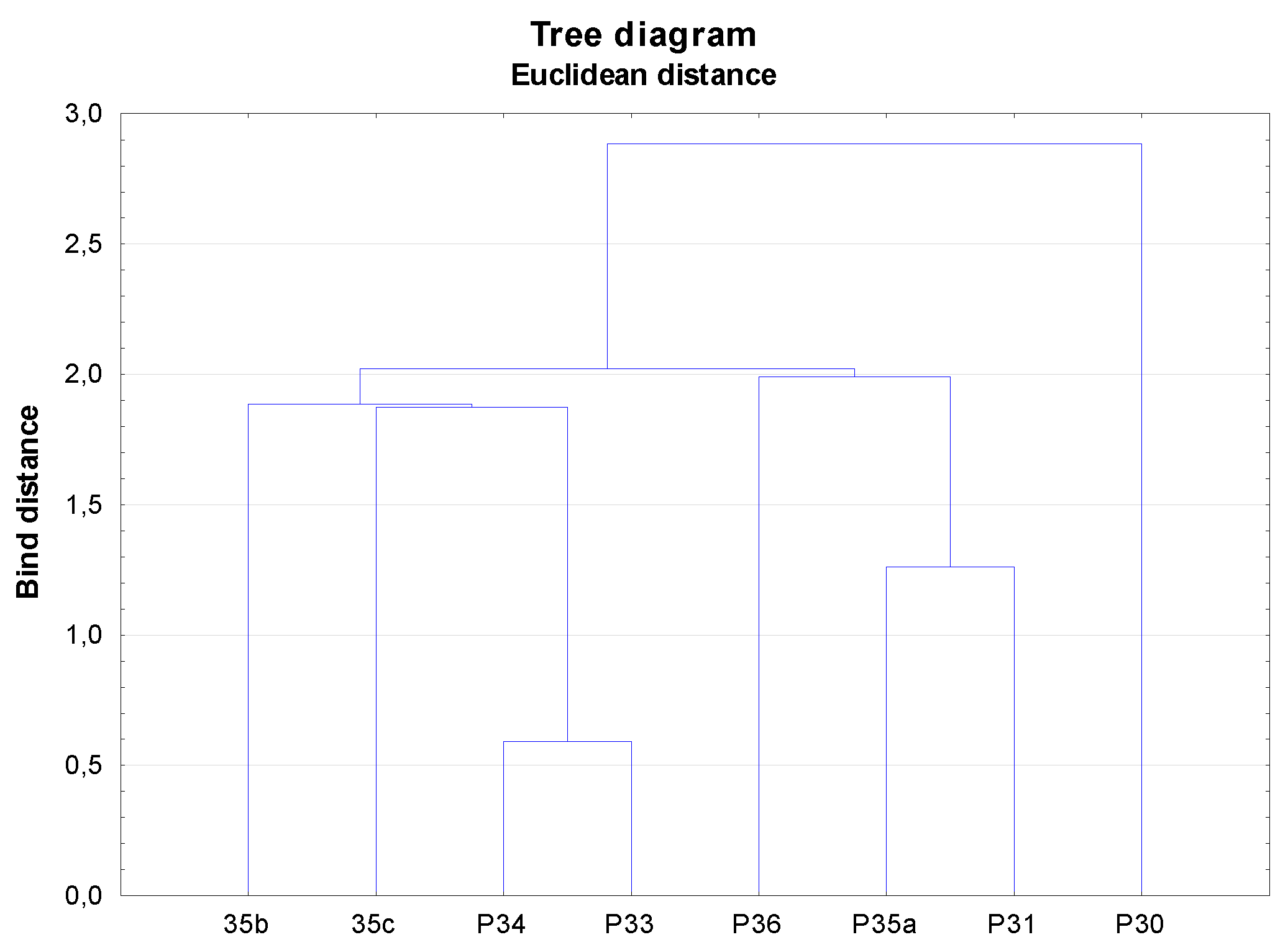

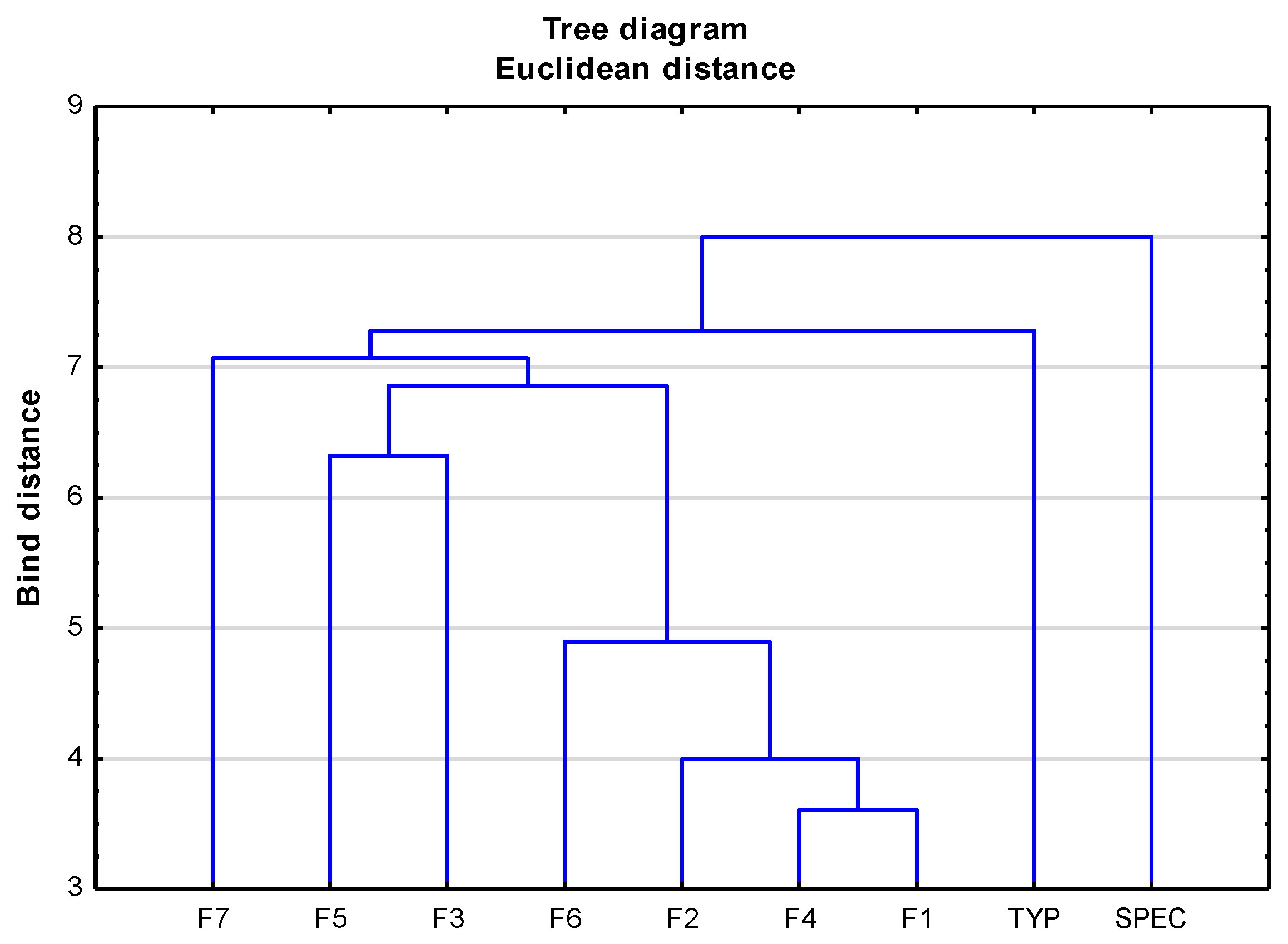
| Variable (Question) | Factor Loading 1 | Factor Loading 2 | Factor Loading 3 |
|---|---|---|---|
| P1 | 0.205 | −0.465 | 0.300 |
| P2 | 0.494 | −0.299 | −0.655 |
| P3 | −0.127 | 0.566 | 0.162 |
| P4 | −0.398 | −0.016 | −0.707 |
| P5 | −0.966 | 0.010 | 0.035 |
| P6 | −0.924 | 0.127 | 0.032 |
| P7 | −0.950 | 0.009 | −0.031 |
| P8 | 0.044 | 0.840 | 0.128 |
| P9 | 0.110 | −0.897 | −0.154 |
| P10 | 0.084 | −0.159 | −0.870 |
| P11 | −0179 | −0109 | −0.052 |
| Share (%) | 29.1 | 19.9 | 16.8 |
| Variable (Question) | Factor Loading 1 | Factor Loading 2 | Factor Loading 3 |
|---|---|---|---|
| P12A | 0.237 | 0.151 | 0.135 |
| P12B | 0.336 | 0.293 | 0.276 |
| P13 | −0.196 | 0.101 | −0.868 |
| P14 | 0.023 | 0.140 | 0.093 |
| P15 | 0.779 | 0.148 | 0.069 |
| P16 | 0.940 | 0.037 | 0.073 |
| P17 | −0.187 | −0.948 | 0.062 |
| P18 | −0.608 | −0.463 | 0.088 |
| P20 | 0.003 | −0.936 | −0.122 |
| P22 | −0.048 | 0.190 | 0.834 |
| Share (%) | 22.80 | 21.31 | 15.83 |
| Variable (Question) | Factor Loading 1 | Factor Loading 2 | Factor Loading 3 |
|---|---|---|---|
| P29 | −0.285 | −0.787 | 0.151 |
| P30 | −0.107 | 0.725 | 0.225 |
| P33 | 0.955 | 0.092 | 0.030 |
| P34 | 0.975 | 0.072 | 0.057 |
| P35a | −0.071 | 0.187 | −0.898 |
| P35b | 0.091 | 0.290 | 0.902 |
| P35c | 0.193 | −0.651 | −0.266 |
| P36 | −0.772 | 0.285 | −0.133 |
| Share (%) | 32.52 | 22.11 | 22.40 |
| Function * | Mean | Stand. Dev. |
|---|---|---|
| F1 | 4.60 | 0.68 |
| F2 | 4.50 | 0.76 |
| F3 | 3.45 | 0.95 |
| F4 | 4.95 | 0.22 |
| F5 | 3.85 | 1.39 |
| F6 | 4.40 | 1.19 |
| F7 | 3.50 | 1.43 |
Publisher’s Note: MDPI stays neutral with regard to jurisdictional claims in published maps and institutional affiliations. |
© 2021 by the authors. Licensee MDPI, Basel, Switzerland. This article is an open access article distributed under the terms and conditions of the Creative Commons Attribution (CC BY) license (https://creativecommons.org/licenses/by/4.0/).
Share and Cite
Skawińska, E.; Zalewski, R.I.; Wyrwa, J.; Ślusarz, B. Implementation of Food Retail Functions in Poland in the SARS-CoV-2 Pandemic. Agronomy 2021, 11, 1962. https://doi.org/10.3390/agronomy11101962
Skawińska E, Zalewski RI, Wyrwa J, Ślusarz B. Implementation of Food Retail Functions in Poland in the SARS-CoV-2 Pandemic. Agronomy. 2021; 11(10):1962. https://doi.org/10.3390/agronomy11101962
Chicago/Turabian StyleSkawińska, Eulalia, Romuald I. Zalewski, Joanna Wyrwa, and Bogdan Ślusarz. 2021. "Implementation of Food Retail Functions in Poland in the SARS-CoV-2 Pandemic" Agronomy 11, no. 10: 1962. https://doi.org/10.3390/agronomy11101962
APA StyleSkawińska, E., Zalewski, R. I., Wyrwa, J., & Ślusarz, B. (2021). Implementation of Food Retail Functions in Poland in the SARS-CoV-2 Pandemic. Agronomy, 11(10), 1962. https://doi.org/10.3390/agronomy11101962






